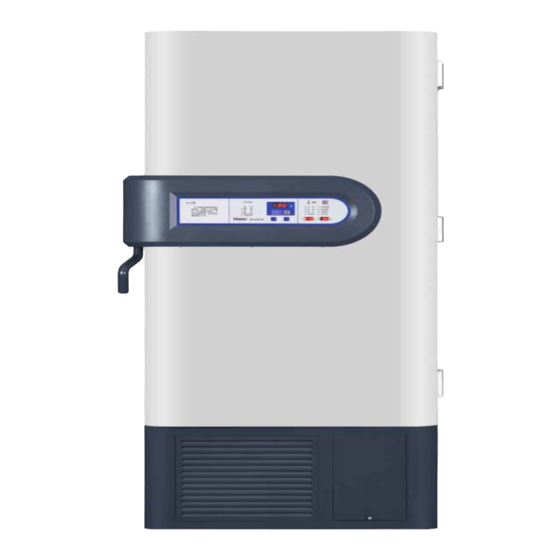
Table of Contents
Advertisement
Advertisement
Table of Contents

Summarization of Contents
Product Designation System
Type Naming Regulations
Explains the structure and meaning of product model names and codes.
Component Identification (Parts Layout)
Display Structure
Identifies components of the display interface.
Box Structure
Details the physical construction and components of the refrigerator cabinet.
Electronic Structure
Describes the internal electronic components and their layout.
System Architecture
Outlines the overall system design and major components.
Cooling System Details
Cooling Unit Parts
Lists and details components within the cooling system.
Refrigeration Circuits
Diagrams and explains the refrigeration system flow.
Circuit Diagram
Provides schematic diagrams of the electrical circuits.
Main PCB and Connections
Connections on Main PCB
Details the connectors and their functions on the main PCB.
Sensor Specifications
NTC Sensor Resistance vs. Temperature
NTC sensor resistance data across various temperatures.
PT100 Sensor Resistance vs. Temperature
PT100 sensor resistance data across various temperatures.
Transportation and Installation Guide
Product Transportation and Package Removal
Details the process of moving and unpacking the refrigerator.
Entering the Placement Room
Instructions for maneuvering the unit into its final location.
Installation Site and Precautions
Guidelines for proper installation and important considerations.
LCD Control Panel Operations
Unlock Control Panel
Procedure for unlocking the control panel settings.
Temperature Setting Adjustment
How to adjust the temperature settings.
High Temperature Alarm Setup
Configuration for the high-temperature alarm.
Low Temperature Alarm Setup
Configuration for the low-temperature alarm.
Special Function Settings
Password Value Configuration
How to set or change the unlock password.
Start Delay Configuration
Procedure for setting compressor start delay.
Temperature Calibration Procedure
Steps for calibrating temperature readings.
Condensate Fan Control
Explanation of condensate fan operation and control.
Battery and Fault Management
Battery Control Requirements
Guidelines for managing the unit's battery power.
Interpreting Fault Codes
Interpretation of error codes displayed by the system.
General Precautions and Fault Analysis
General Precautions
General safety and operational advice.
Detailed Fault Code Analysis
Details common fault codes and their causes.
Product Operation and Maintenance
Principle of Operation
Explains the fundamental working mechanism of the refrigeration system.
Using the Ultra-low Temperature Cabinet
Instructions for using the ultra-low temperature cabinet.
Pressure Switch and Refrigerant Infusion
Details on pressure switches and refrigerant infusion.
Fan Specifications
Technical specifications for the unit's fans.
Refrigerant Handling
Refrigerating Machine Diagram
Visual representation of the refrigeration system components.
Compressor Specifications
Technical specifications for the compressors.
Refrigerant Properties and Characteristics
Information about the properties and handling of refrigerants.
Refrigerant Perfusion Process Steps
Steps involved in filling the system with refrigerant.
Troubleshooting Common Issues
High Temp Compressor Start Failure
Troubleshooting steps for a non-starting high-temperature compressor.
Low Temp Compressor Start Failure
Troubleshooting steps for a non-starting low-temperature compressor.
Fan Malfunction Diagnosis
Diagnosing and fixing fan operational issues.
High Cabinet Temperature Resolution
Addressing issues related to elevated cabinet temperatures.
Display Errors (E0, E1, E2)
Troubleshooting error codes E0, E1, and E2 on the display.
Excessive Cabinet Noise Solutions
Identifying and resolving excessive noise from the unit.
Cooling System Failure Diagnosis
Diagnosing and fixing cooling failures.
Temperature Reading Inaccuracies
Resolving differences between displayed and measured temperatures.
Large Upper/Lower Part Temp Difference
Addressing significant temperature variations between cabinet sections.
Unstable Internal Temperatures
Troubleshooting unstable internal temperature readings.
Display Error Codes (E0 and others)
Resolving various error codes displayed on the panel.
Low Temperature Compressor Faults
Diagnosing issues with the low-temperature compressor.
Temperature Maintenance Issues
Addressing inability to maintain temperature or reach setpoints.
Voltage Display Anomalies
Troubleshooting voltage display issues.
Operational Guidelines and Precautions
Proper Usage Guidelines
Guidelines for correct and efficient operation.
Safety Requirements
Safety precautions for using the equipment.
Handling Special Circumstances
Procedures for handling common operational faults and issues.
Routine Maintenance Procedures
Cleaning the Storage Box
Instructions for cleaning the interior and exterior of the storage box.
Cleaning the Condenser Filter Screen
Steps for cleaning the condenser filter screen.
Cleaning Filter Screen with Water
Process for cleaning the filter screen using water.
Defrosting Inner Walls
Method for defrosting the inner walls of the cabinet.
Battery Maintenance Guidelines
Guidelines for maintaining the unit's battery.
Frequently Asked Questions (FAQ)
Common Faults Analysis and Maintenance
Analysis and solutions for common operational faults.
Low Battery Alarm Troubleshooting
Troubleshooting and actions for low battery alarms.
Dirty Condenser Alarm Causes
Identifying causes and solutions for dirty condenser alarms.









Need help?
Do you have a question about the DW-86L728S and is the answer not in the manual?
Questions and answers